 Features Overview
Features Overview
The main features of PDF-XChange Editor are detailed below:
Create and Manipulate Documents
•Create PDF documents from image files, markdown files, text files, RTF files or the local scanner. See here for further information.
•Print documents. See here for further information.
•Email documents. See here for further information.
•Combine multiple input documents into a single file. See here for further information.
•Convert documents to/from PDF and a range of other formats.
•Secure documents. See here for further information.
•Use Digital Signatures to sign documents and demonstrate authenticity. See here for further information.
•Integrate Sharepoint, Dropbox, Google Drive and MSOffice 365. See here for further information.
•Use the OCR engine to avail of advanced optical character recognition. See here for further information.
Edit Documents
•Add Watermarks, Barcodes, Images and Backgrounds to documents.
•Edit document pages, with options to Number, Rotate, Split, Resize, Replace, Delete, Export, Insert, Extract and Crop pages.
•Use editing aids to assist in document editing:
•Rulers, Grids and Guides enable precise placement/measurement of document content.
•Snapping ensures that content is aligned flawlessly.
•Use Macros to determine complicated components of the output process in simple terms.
•Use the Preferences options to customize the workspace and application settings.
•Use the JavaScript Console to add JavaScript to documents.
•Use the Launch Applications toolbar to open third party software from PDF-XChange Editor.
•Customize toolbars in order to group specified functions and save space on the user interface. See here for further information.
•Use the Form tab to create and edit fillable forms.
•View/edit/create PDF portfolio files, as detailed here.
Utilize Tools and Features to Enhance Documents
•The File Attachment and Sound Tool add links to external files and sound effects to documents.
•The Highlight, Strikeout and Underline Text tools can be used to edit and enhance document text.
•The Link Tool creates links to external sources.
•The Loupe Tool and Pan and Zoom pane provide dynamic methods to view and edit documents at increased/decreased levels of zoom.
•The Measuring Tools can be used to measure the distance between document locations and the perimeter/area of customized shapes. The Calibrate Measurement feature can be used to create scales for these tools.
•The Read Out Loud Feature can be used to read selected text out loud.
•The Shape Tools can be used to add adjustable shape annotations to documents. Multiple default shapes are available, such as circles and rectangles, as well as the option to add freehand annotations.
•The Snapshot Tool takes screenshots of pages/selected page content and pastes a bitmap copy to the clipboard.
•The Stamp Tool can be used to add standard stamps to documents or create custom stamps from input material.
•There are four ways to add comments to documents:
•The Sticky Note Tool adds sticky-note annotations to documents.
•The Typewriter Tool adds typewriter-style comments to documents.
•The Text Box Tool adds comments contained in text boxes to documents.
•The Callout Tool is similar to the Text Box Tool, but has the additional option to add an adjustable arm to the comment in order to highlight specific document locations.
•The Select Comments Tool provides an efficient way to edit multiple comments simultaneously.
•The Edit Content Tool is used to edit existing document content.
•The Redaction feature is used to redact documents and permanently delete document content.
•The Spell Check feature is used to check document spelling.
•The Comment Styles Palette can be used to save customized comment and annotation styles for subsequent use.
Use Editing Panes to Assist in Document Editing
•The Comments pane is used to view/edit comments, annotations and markups.
•The Attachments pane is used to view/edit attachments.
•The Fields pane is used to view/edit form fields such as radio buttons and dropdown menus.
•The Signatures pane is used to view/edit digital signatures.
•The Layers pane is used to view/edit document layers, such as those used by InDesign, AutoCAD and Visio.
•The Content pane is used to view/edit base content.
•The Destinations pane is used to view/edit named destinations.
•The 3D Model Tree pane is used to view/edit the hierarchy of selected 3D content in documents.
•The Links pane is used to view/edit the links in documents.
•The Pan and Zoom pane is used to assist in document editing.
•The Stamps Palette pane is used to view/edit stamps.
•The Comment Styles Palette is used to view/edit comment styles.
•The Spell Check pane is used to check document spelling.
•The Document Recovery pane is used to view/edit information recovered through the autosave/autorecovery features.
•The History pane is used to view the history of documents opened in PDF-XChange Editor and can be used to browse/open those documents.
•The Properties pane is used to view/edit the properties of selected document content.
Additionally, see the Operations Guide for step-by-step instructions on all available operations in PDF-XChange Editor.
The User Interface is detailed here.